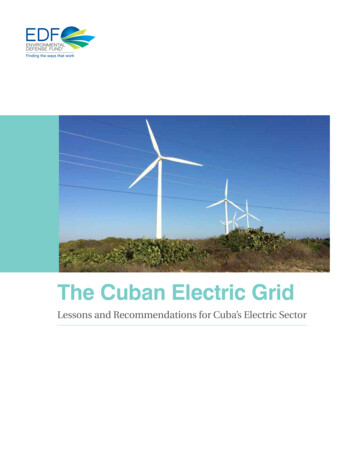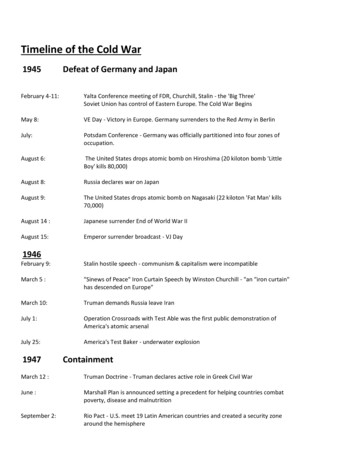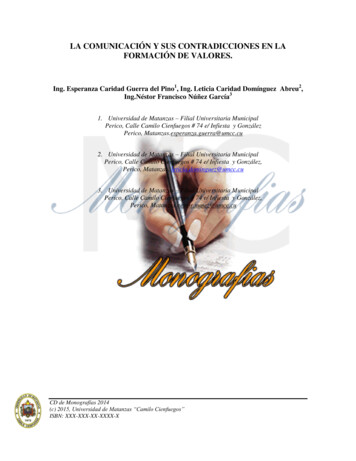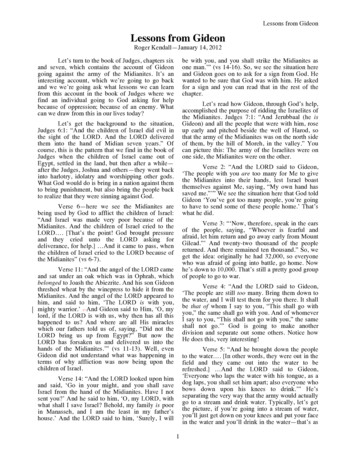
Transcription
The Cuban Electric GridLessons and Recommendations for Cuba’s Electric Sector
Environmental Defense Fund is dedicated to protecting the environmental rights of all people,including the right to clean air, clean water, healthy food, and flourishing ecosystems. Guidedby science, we work to create practical solutions that win lasting political, economic, and socialsupport because they are nonpartisan, cost-effective, and fair.
The Cuban Electric GridLessons and Recommendations for Cuba’s Electric SectorAuthorsMichael PanfilSENIOR ATTORNEY AND DIRECTOR OF FEDERAL ENERGY POLICYDaniel WhittleSENIOR ATTORNEY AND SENIOR DIRECTOR, CUBA PROGRAMKorey Silverman-Roati
AcknowledgmentsThe authors would like to thank Megan Reilly Cayten and Jorge R. Piñon for their helpfulcomments and thoughts. Support from the Ford Foundation, the Rockefeller Foundation’sBellagio Center and the Research Initiative for the Sustainable Development of Cuba helpedmake this paper possible. All conclusions and errors are the authors’ own.Cover photo by Lisa Valdivia October 2017 Environmental Defense FundThe report is available online at edf.org/electricity-in-cuba
Table of contentsExecutive summaryBackground on the energy sectorPre-1991 relationship with USSRPost-Soviet restructuring (1991–2005)Energy revolutionRelationship with VenezuelaCurrent electricity sectorFuel sourcesCentralized generationTransmission, distribution and distributed e change and energyNear-term futureFuture of Cuba’s resources19192123Recommendations27Notes33Energy futureEnvironmental Defense Fund53
DefinitionsBagasse is the pulpy plant residue left over after juice has been extracted.1 Sugarcanebagasse can be burned in power plants to generate electricity.Capacity refers to the maximum output that a given generator of electricity is able toproduce. Most of the capacity figures in this report are given in MW. One MW is roughlyenough electricity to power 750 homes in the United States.2Distributed Generation (DG)refers to power generation at thepoint of consumption, withindistribution networks, or on thecustomer side of the network.3 Incontrast, centralized generationoften involves larger plants thatdistribute power over longerdistances through a transmissionnetwork.Distribution refers to theelectricity delivery system thatdelivers power to homes andbusiness from substations ordistributed generators at a lowvoltage rate.4Centralized generationTransmissiononutitribsiDDistributed generationGeneration refers to the amountof electricity a generator producesSource: Institute for Energy Researchover a given period of time,usually an hour. Most of thegeneration figures given in this report are in kWh. A 1 MW (1,000 kW) capacity plantoperating continuously at capacity over one hour will thus produce 1,000 kWh.Transmission refers to an electricity delivery system that delivers power from centralizedgenerators to substations at a high voltage level, usually too high to be used by homes orbusinesses.5Specific Fuel Consumption in power plants is the amount of fuel needed to produce agiven amount of power. In this report, the unit used is the grams of fuel needed to producea kWh of electricity.4THE CUBAN ELECTRIC GRID
Executive summaryFrom its 1959 revolution until the Soviet Union collapsed in 1991, Cuba imported oil from theSoviet Union through non-commercial barter agreements. It leveraged this cheap source ofpower to build infrastructure and expand electricity access to over 95% of its citizens.6 The SovietUnion’s collapse and consequent severing of oil import agreements severely and adverselyimpacted the Cuban electricity sector and economy. The electric sector was additionallydevastated by blackouts and extreme weather events.In response, the Cuban Government implemented the “Energy Revolution.” This policysuccessfully replaced millions of inefficient household appliances with more efficientalternatives. The program was notable both for its impact on electricity demand and its speed.For example, lightbulbs throughout the country were replaced in roughly six months andreduced consumption 3–4% annually.7In the mid-2000s, the Cuban government reached an agreement with a new exporter ofheavily subsidized oil, Venezuela. This agreement between the countries sent Cuban doctorsand professionals to Venezuela in exchange for inexpensive, imported oil. Venezuela providedroughly 100,000 barrels per day (slightly more than 60% of Cuba’s supply) to Cuba under theagreement. A recent economic downturn in Venezuela, however, has resulted in loweredshipments of oil in the summer of 2016. In response, Cuban leaders have implemented energysaving measures in the state sector, avoiding cuts to residential demand (as of July 2016).8Currently, electricity generation is dominated by oil. Fuel oil, whether in centralized ordistributed systems, makes up over 80% of the generation supply.9 Most of Cuba’s oil comesfrom Venezuela, but between 30-40% of oil supply is produced domestically. The domestic oil ishigh-sulfur crude and burning this dirty oil leads to higher rates of failure in power plants andlocal pollution that causes serious respiratory ailments. Two combined-cycle natural gasgeneration plants meet about 14% of Cuban demand for electricity, with a third plant recentlyconstructed. Roughly 50% of Cuba’s electric power comes from imported fuel. Fuel costsaccount for 70–80% of generation costs and Cuba spends more money on energy, about 14% ofGDP, than most nations.10 A single state-owned utility, Unión Eléctrica, is responsible formanaging and operating the electric grid.Much of Cuba’s electric grid utilizes oil high-sulfur crude oil, fuel oil, and diesel fuel. Thisresource is particularly polluting and creates significant harmful local air pollutants, includinghigh levels of soot, sulfur dioxide, and nitrogen oxides.11 Emissions from these pollutants areassociated with a number of respiratory ailments including decreased lung function, aggravatedasthma, and premature death.12 These significant harms are amplified by the distributed natureof the grid, where generation is often located nearby large centers of the population.Cuba’s renewable energy resources currently represent a small but growing fraction ofcapacity. The country currently only generates about 4% of its electricity from renewables but isinvested in expanding that profile. The Cuban government set a goal of 24% of generation fromrenewable sources by 2030.13 The country recently signed agreements to build large, utility scalesolar, wind, and bagasse plants. In each of these projects, the Cuban government has usedforeign private parties to build the plants.Environmental Defense Fund5
6THE CUBAN ELECTRIC GRID EDF 2010/PAM BAKERA key, unique aspect of Cuba’s grid is its high levels of distributed generation, or powergenerated at or near the point of consumption. More than 40% of total generation capacity inthe country is in distributed generation systems, a percentage second only to Denmark.14 Thisdistributed generation provides resiliency benefits against natural disasters like hurricanes anddisruptions and centralized power plants, but may be less efficient than centralized generation.Burning high sulfur diesel and fuel oil in distributed systems also brings harmful local pollutantscloser to population centers.Most Cubans pay very little for electricity as an absolute figure. The residential electricity tariffis gradated based on consumption, with higher per kWh prices for larger consumers. The averagehousehold pays less than 0.02 per kWh consumed.15 This rate, heavily subsidized by the govern ment, is significantly lower than the average for neighboring Caribbean nations ( 0.33/kWh).The average wage in Cuba, about 20/month, suggests however that the average household paysrelatively significant amounts for electricity as a percentage of income. In contrast, industrialconsumers are charged on a time-of-use tariff. Demand peaks in summer months.16 Someevidence suggests system-wide demand peaks in the evening—or at least did in 2009.17 Regardless,power consumption in Cuba is growing, including residential power usage increasing by 66.5%over the last decade and state sector consumption rising by 9.6% over the same period.18As an island nation, with approximately 10% of its population living in low-lying areas on thecoast, Cuba will feel the acute effects of climate change. The Intergovernmental Panel onClimate Change (IPCC) projects that the country could lose 3% of its land by 2050.19 Cuba hasalready seen an increase in the frequency and intensity of hurricanes. Long a participant inclimate change action, Cuba hasrenewed its commitment bysigning the Paris Agreementin 2016. Cuba submitted acontribution to that agreement,in which it pledged to massivelyincrease renewable generation,increasing to over 650 MW eachof solar, wind, and bagassegenerating capacity.20 Thiscommitment is presented inbroad strokes, however, and maybe difficult to reach. Findingcost-effective and innovativesolutions will be critical tomeeting these goals.Cuba’s energy sector isapproaching an inflection point.Significantly lowered Venezuelanoil imports could drive the needfor a fundamentally redesignedenergy sector. The easing ofaspects of U.S. trade and travelsanctions in 2015 and 2016 hasresulted in an influx of tourismand electricity demand.21 Theway Cuba responds to thesenear term challenges will helpset the stage for its long termenergy future.
This paper sets forth four sections. “Background on the energy sector” (page 8) provideshistorical context and background of the country’s energy sector. “Current electricity sector”(page 11) describes the current energy sector, including details on the country’s fuel sources,generation, transmission/distribution, and consumption of electricity. “Energy future” (page 19describes key aspects of Cuba’s energy future, including a focus on the future of the country’senergy resources. Finally, “Recommendations” (page 27) provides a set of recommendationsbased on the analysis contained in prior sections.These recommendations are focused upon cost-effective actions that may support the longterm sustainability and reliability of the Cuban energy sector. Particularly, this paper recommends: Knowledge sharing. Cuba should leverage already existing experiences from nations withsimilar energy profiles, particularly island jurisdictions and nations with highly distributedsystems. Best practices and lessons learned, especially with respect to integratingrenewable generation, can provide helpful experience and context. Competitive procurement. Cost comparison across resources is critical to makinginformed investment decisions. Rather than individual bilateral agreements, Cuba shouldconsider an informed process able to competitively procure new electricity generation. Renewable distributed generation. Cuba should consider conducting a feasibility andcost/benefit study with respect to increasing renewable distributed generation. Byleveraging the already existing highly distributed grid, a greater reliance on distributedrenewable assets may provide discrete cost, reliability, environmental, and timelineadvantages over potential alternatives. Expand energy efficiency. Cuba should consider expanding energy efficiency efforts toother areas and sectors, including supply-side, non-appliance, and industrial sectors.Previous energy efficiency programs have worked well, and an expansion upon an alreadysuccessful model could reduce consumption in sectors that have not yet been targeted. Examine tariff structure. Current energy tariffs are structured to encourage energyconservation. Changes to the current structure could further support this aim, particularlywith respect to industrial consumers’ time of use rate. Microgrids at high-demand locations. Microgrids sited at high-consuming locations couldease transmission and distribution congestion and provide resiliency and reliabilitybenefits for significant loads. Invest in diverse mix of lower-carbon resources. Investment in lower-carbon andalternative energy resources may allow for a cost-effective, clean energy future impossiblewith further buildout of dirty, fuel oil based generation. Evaluation of sources includingsolar, wind, natural gas, and energy efficiency resources should occur in the context ofcurrent emissions and cost profiles. Consider mechanisms to stimulate and clarify foreign investment. Implementing certainpolicies, laws, and actions may help to increase foreign investment in renewable energyprojects by mitigating certain types of risk or increasing upfront capital.Environmental Defense Fund7
Background on the energy sectorThis section describes four distinct time periods in the history of the Cuban energy sector:(1) the period from revolution until 1991, when oil imports from the Soviet Union were a keydriver of Cuban energy; (2) the ensuing period, when Cuba attempted to respond to economiccrisis with energy efficiency, renewables, and domestic oil production; (3) Cuba’s mid-2000senergy revolution, and its massive rollout of energy efficiency measures in response tohurricane-induced blackouts; and (4) Cuba’s oil-importing relationship with Venezuela.Pre-1991 relationship with USSRFrom the early years of Cuba’s revolutionary government until the early 1990s, Cuba’srelationship with the Soviet Union was the dominant force in the state’s energy sector. Cubaimported nearly 90% of its fuel needs from the Soviet Union over this time period.22 Cubaaccessed these fuel imports through a favorable barter agreement, under which Cuba providedsugar and other commodity exports in exchange for oil imports from the Soviet Union.23Cuba utilized this heavily subsidized oil to expand electricity access to its citizens. In 1959,only about 50% of households in the island nation had access to electricity. By 1989, the electricgrid provided service to 95% of households.24 Total installed power generating capacity grewfrom 400 MW in 1958 to 4,000 MW in 1990.25 This capacity paled in comparison to somecountries; for example, Cuba’s generating capacity was roughly 13% of the United Statesgeneration capacity per person in 1990. Cuba significantly outpaced other neighbors, however.By 1990 Cuba had roughly 1.8 times more generating capacity per person than the DominicanRepublic and 1.3 times more than Jamaica.26 At the same time, annual electricity consumptionin Cuba grew from roughly 1,500 GWh to 9,700 GWh over the same period (1958 to 1990).27Because imported oil was central to this expansion, however, Cuba’s energy sector wasimmediately and immensely stressed following the collapse of the Soviet Union in 1991 and theresulting termination of the countries’ oil-for-sugar agreement.Post-Soviet restructuring (1991–2005)The Cuban economy contracted rapidly after the Soviet Union’s collapse. Cuba’s GDP fell 35%between 1989 and 1993 and oil, gas, and food shortages regularly affected the country.28 TheCuban government responded with a 1993 National Assembly-approved national energy policy.This policy set forth three overarching goals—invest in energy efficiency and renewable energy,increase domestic oil production, and invest in the sugar industry to more efficiently utilizebagasse (sugarcane biomass) electricity generation.29 Sugar has historically been a key export forCuba and the country had previously traded sugar for oil from the Soviet Union.Cuba focused its renewable energy efforts in rural areas. The country mobilized its scientificcommunity to look at efficiency and renewable alternatives to centralized oil generation. It thenoutfitted key institutions that previously had been without electricity—rural schools, healthclinics and social centers—with photovoltaic (PV) solar systems and micro-hydro plants.30 The8THE CUBAN ELECTRIC GRID
program successfully installed 2,364 schools and hundreds of doctors’ offices and hospitals withPV systems by 2003.31To increase domestic oil production, Cuba chose to allow third-party entities entry to thesector. Once a completely state-dominated sector, Cuba opened up a portion of its oil and gasexploration to foreign companies in 1993. Cupet, the state-owned oil company, adopted aproduction-sharing agreement (PSA) contractual structure with private oil companies. The PSAawards rights to third-party contractors to explore and produce oil within a specificgeographical area at their own risk and recover costs, conditioned on shared profits withCupet.32 Most foreign involvement in Cuba’s domestic production has been through a PSAbetween Cupet and a Canadian company, Sherritt.33Investment in bagasse was less successful. Without support from the Soviet Union and with ashrinking economy, Cuba saw a huge collapse in sugarcane production. Production fell 57.4%from 1989 to 2000, and the downward trend has continued.34 As a result, the proportion ofelectricity for primary consumption produced by bagasse has likewise fallen.35These post-Soviet Union policy pivots in the 1990s proved insufficient in reducing stressupon the electric grid. The country’s 11 thermoelectric plants only functioned roughly half thetime due to aging infrastructure, complications from using high-sulfur heavy crude in powerplants, and natural disasters. Hurricane-related blackouts in 2004 left one million without powerfor ten days.36 The energy sector during this period thus faced internal reliability threats fromunder-performing power plants and external resiliency threats from extreme weather.Energy revolutionThe Cuban government responded to these energy resiliency and reliability issues with renewedefforts, through a policy known as the ‘Energy Revolution.’ The policy included severaloverarching goals,37 and two--increased energy efficiency and greater use of sustainableresources—are emblematic of the variability of success experienced.38Energy efficiencyIncreasing energy efficiency quickly proved successful. In a matter of months, the policyreplaced millions of appliances with more efficient, upgraded alternatives in Cuban homes.Cuba’s energy efficiency program is notable both for its speed and its breadth. Over roughly sixmonths the country quickly switched to compact fluorescent lightbulbs, reducing electricityconsumption 3–4% annually. Cuban officials likewise replaced 2 million refrigerators and1 million fans, installing more efficient, upgraded appliances. They distributed 3.3 million newelectric stoves, 3.5 million rice cookers, and 3.2 million pressure cookers, replacing kerosene andliquid petroleum gas stoves.39 Nearly all of the appliances were purchased from China, as part ofa larger credit deal that also sent vehicles and distributed power generation systems to Cuba.40Notably, the energy efficiency measures were focused on the residential sector, and withinthis sector, the measures specifically targeted appliance upgrades. This narrow focus allowedCuban leaders to act quickly to affect a large portion of demand but left open the possibility ofenacting further energy efficiency measures in other sectors with a much broader scope.Further energy efficiency measures that the government could enact are discussed inRecommendation 2, “Invest in solar energy distributed generation” (page 28).41In addition to appliance upgrades, Cuban officials implemented a new electricity tariff toreduce demand. The tariff introduced progressive rates based on consumption levels, i.e.,a tiered rate structure.42 Consumer electricity cost remained extremely inexpensive, however,through heavy subsides – and remains so to this day. Even with the new tariff, the averageconsumer pays less than 0.02/kWh,43 far lower than the average tariff across several Caribbeancountries ( 0.33).44 Due to significantly lower average wages in Cuba, however, electricity pricesas a percent of income are actually higher in Cuba than in neighboring island countries. Cuba’sEnvironmental Defense Fund9
electricity tariff structure, particularly in the context of average household income, is discussedin more detail in “Demand consumption” (page 17).Renewable resourcesThe Energy Revolution proved unable to increase the deployment of sustainable and renewableresources projected. Indeed, renewable electricity generation did not increase substantiallyuntil years later and remains an under-deployed and underdeveloped resource.45 Instead, fueloil remains the dominant source of electricity generation.Relationship with VenezuelaCuba’s relationship with Venezuela is central to Cuba’s current energy sector. The two countriesentered into a barter agreement in 2000, which increased in the mid-2000s, and was similar tothe previous barter agreement between Cuba and the Soviet Union. Under the agreement,Venezuela provides Cuba roughly 100,000 barrels per day of oil. In exchange, Cuba providesVenezuela services rendered by Cuban doctors and other professionals. Imports under thisagreement currently account for about half of Cuban energy needs46 and fulfill more than 60% ofits crude oil supply needs. Between 2003 and 2009, Cuba imported 14 billion worth of oil. Eightbillion was exchanged for services rendered by the doctor/professional deployment, and theother 6 billion was converted to low-interest 25-year debt.47The agreement continues to provide Cuba with inexpensive oil, but recent economic strife inVenezuela may endanger the agreement’s future. As of June 30, 2016, Venezuela was still sendingabout 90,000 b/d to Cuba. Cash payments to doctors deployed in Venezuela have been hinderedhowever, suggesting potential uncertainty for the agreement’s future. In response to Venezuelaneconomic troubles, Cuba ordered some state firms and joint ventures to reduce fuelconsumption in June 2016.48 More recently, Cuba has begun importing crude oil from Russia forthe first time since the collapse of the Soviet Union.49Cuban President Raul Castro first publicly acknowledged that Cuba’s Venezuelan oil importswere diminishing in early July 2016. The government introduced targeted measures to respondto this decrease in oil imports, particularly focused on state sector energy consumption (notablygiving preference to continued energy access in the residential, tourism, and nickel productionsectors). State sector energy reductions include reduced bus services, less air conditioning, andreduced work days, with fuel allotments for government vehicles slashed in half.50Should Venezuelan oil imports continue to diminish, Cuba must determine how best torespond. The recent imported crude oil is, according to expert Jorge Pinon, a clear sign that“Cuba is diversifying its long-term supply contracts in the event that its October 2000 subsidizedoil agreement with Venezuela is terminated.”51 Blackouts remain a bad word in Cuban politics,52and leaders are wary of continuing a history of dependence on one import source for futureenergy needs.53 However, a transition away from inexpensive imported oil requires smart policyplanning and innovative thinking to facilitate efficient, reliable, sustainable, and cost-effectiveelectricity.10THE CUBAN ELECTRIC GRID
Current electricity sectorThis section describes the four key components to Cuba’s electricity sector: (1) fuel sources,including fossil fuels and renewable energy resources; (2) existing centralized generation; (3)transmission, distribution, and distributed generation; and (4) electric consumption anddemand.Fuel sourcesOverallCuba relies heavily upon liquid fuels for electricity generation. Indeed, it has the 5th highestpercentage of total energy derived from liquid fuels in the world.54 Fuel accounts for 70–80% oftotal generation costs.55Oil remains the dominant fuel source for electricity. Of 19,366 GWh of gross electricity outputin 2014, 61% was generated from fuel oil for centralized plants, 20% from fuel oil for distributedgenerators, 14% from natural gas, 4% from Independent Power Producer (IPP) oil includingbiodiesel from sugarcane biomass, and around 1% from other renewables.56 These fuel sourcesare represented in Figure 1 below.Imports make up a substantial portion of Cuba’s fuel mix. In 2013, for example, Cubaimported 61.8% of its total crude oil consumption from Venezuela. The vast majority of thisimported oil was used for electricity generation.57FIGURE 1Electric generation by fuel source in 201458Hydro-wind-solar141 GWh (1%)IPP oil838 GWh (4%)Natural gas2,794 GWh (14%)Thermoelectric oil11,738 GWh (61%)Distributed oil3,855 GWh (20%)Source: Jorge R. PiñónEnvironmental Defense Fund11
Key players (government entities)Ministry of Energy and Mines. Energy policy in Cuba is state driven, directed by the Ministry ofEnergy and Mines. Cuba had no ministry of energy until 2012. Before, the Ministry of Economyand Planning coordinated the Energy Commission, which in turn formulated the nation’senergy strategy.59 At that time, the Ministry of Basic Industries oversaw the electric sector. In2012, Cuba separated out energy by creating the Ministry of Energy and Mines (and eliminatingthe Ministry of Basic Industries). This new agency assumed responsibility for all activitiesrelated to the energy sector, including oversight of the state-run utility Unión Eléctrica.60CITMA. The ministry of Science, Technology, and Environment (CITMA) directs environmentalpolicy. It was established in 1994 based on the desire to make sustainable development andenvironmental protection a policy priority and to provide a clearer and more integratedmandate for environmental governance.61 The agency received additional authority with thepassage of Law No. 81, the Environmental Law, in 1997. A key provision of the law for electricitygeneration, Article 125, states that Cuba should prefer the use of renewable energy resourceswherever feasible.62Cupet. Cupet is Cuba’s vertically integrated state-run oil company. It is responsible forexploration, production, and refining domestic oil. It may enter into third party contracts withprivate parties.63Cubasolar. Although technically not a governmental organization, Cubasolar is a quasiindependent organization which operates under the auspices of CITMA. It was created in 1994to promote the use of renewable energy in Cuba.64 Its tasks include organizing events,demonstration projects, and education on renewables. The organization also installed Cuba’sfirst wind farm.65Key entities (private party involvement)Sherritt. As described above, the Canadian company Sherritt is a key player in both the Cubanextractives and power production industries. It partners with the Cuban government in oil andnatural gas production and electricity generation from natural gas. The company produces justover 18,000 b/d of oil with Cupet66 and about 21,000 b/d oil equivalent of natural gas throughEnergas.67 In 2015, Sherritt received 117.5 million for oil and gas production services as part ofits agreement with Cupet.68Hive Energy. Hive Energy recently entered into the Cuban solar energy market. The Britishcompany was awarded a contract by Unión Eléctrica to build a 50 MW solar project in Mariel.This project, to be Cuba’s largest solar farm by far, is expected to be completed in 2018.69 Becausethis is the first agreement in a series of desired industrial-scale solar farms, the Mariel projectwill likely act as a pilot for future investment.Goldwind. Goldwind is a Chinese wind turbine manufacturer that has provided wind turbinesfor multiple Cuban wind farms. They will provide the turbines for the planned wind farmHerradura 1, which will be a 51 MW capacity farm made up of thirty four 1.5 MW turbines.70Fossil fuelsCuba has increased domestic oil production in the last two decades. The country now producesaround 50,000 b/d, or roughly 30-40% of its consumption needs. This represents a dramaticincrease from around 9,000 b/d in 1991.71 Most of this oil consists of low quality, high-sulfur oilthat is extracted from shallow waters just off the coast.72 As described in “Centralized generation”(page 16), burning this high-sulfur oil leads to failures in power stations and harmful local airpollution.12THE CUBAN ELECTRIC GRID
Cupet manages the majority of domestic oil production without foreign involvement, butroughly 18,000 b/d is produced through a production sharing agreement between Cupet andthe Canadian company Sherritt. This agreement, the largest in of its kind currently in place inCuba, provides oil at a unit operating cost of 7.43 per barrel in 2015, with realized prices of 29.91 per barrel.73 This oil is consumed domestically in Cuba and Sherritt receives a portion ofprofits from the Cuban government. Overall, there has been roughly 2 billion in direct foreigninvestment in the oil and gas sector in Cuba since 1991.74Natural gas production makes up a small but significant proportion of Cuba’s fuel sources.Domestic production averages 43 billion cubic feet (21,000 b/d equivalent) per year and allcurrent production is associated natural gas, recovered alongside oil. Cupet estimates therecovery rate of this natural gas to be 94%.75 This natural gas production is conducted througha private/public corporation called Energas, made up of Sherritt, Cupet, and domestic utilityUnión Eléctrica.76RenewablesCuba’s renewable energy profile remains a small percentage of total generation; however, thecountry is laying the groundwork for increases in the near future. This future is described inmore detail in “Future of Cuba’s resources” (page 23). Cuba currently generates around 4% ofits electricity from renewable sources, with bagasse being the major resource.77 In addition,roughly 10,000 households and 34,900 people, or about 0.3% of the population, use electricityfrom renewable off-grid sources.78Centralized generationOverviewCuba had 6,169 MW total installed generating capacity in 2014.79 This represents a 19% growthfrom 2006, when the number stood
Centralized generation 13 Transmission, distribution and distributed generation 15 Demand/consumption 17 Energy future 19 Climate change and energy 19 Near-term future 21 Future of Cuba’s resources 23 . consider an informed process able to competiti










